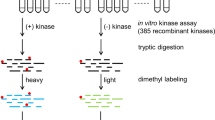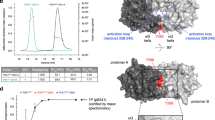Abstract
MAP kinase (relative molecular mass, 42,000), a low abundance serine-threonine protein kinase, is transiently activated in many cell types by a variety of mitogens, including insulin, epidermal growth factor, and phorbol esters1,2. In vitro, MAP kinase will phosphorylate and reactivate S6 kinase II previously inactivated by phosphatase treatment3. Because many of the stimuli that activate MAP kinase are also stimulators of cell proliferation, and regulation of the cell cycle seems to involve a network of protein kinases, MAP kinase could be important in the transmission of stimuli eventually leading to the progression from GO to Gl in the cell cycle. Activated MAP kinase contains both phosphotyrosine and phosphothreonine4. We report here that MAP kinase can be deactivated completely by treatment with either phosphatase 2A, a protein phosphatase specific for phosphoserine and phosphothreonine, or CD45, a phosphotyrosine-specific protein phosphatase. We demonstrate that MAP kinase is only active when both tyrosyl and threonyl residues are phosphorylated and suggest therefore that the enzyme functions in vivo to integrate signals from two distinct transduction pathways.
This is a preview of subscription content, access via your institution
Access options
Subscribe to this journal
Receive 51 print issues and online access
$199.00 per year
only $3.90 per issue
Buy this article
- Purchase on Springer Link
- Instant access to full article PDF
Prices may be subject to local taxes which are calculated during checkout
Similar content being viewed by others
References
Ray, L. B. & Sturgill, T. W. J. biol. Chem. 263, 12721–12727 (1988).
Rossomando, A. J., Payne, D. M., Weber, M. J. & Sturgill, T. W. Proc. natn. Acad. Sci. U.S.A. 86, 6940–6943 (1989).
Sturgill, T. W., Ray, L. B., Erikson, E. & Maller, J. L. Nature 334, 715–718 (1988).
Ray, L. B. & Sturgill, T. W. Proc. natn. Acad. Sci. U.S.A. 85, 3753–3757 (1988).
Ray, L. B. & Sturgill, T. W. Proc. natn. Acad. Sci. U.S.A. 84, 1502–1506 (1987).
Cohen, P. A. Rev. Biochem. 58, 453–508 (1989).
Jones, S. W., Erikson, R. L., Ingebritsen, V. M. & Ingebritsen, T. S. J. biol. Chem. 264, 7747–7753 (1989).
Tonks, N. K., Charbonneau, H., Diltz, C. D., Fischer, E. H. & Walsh, K. A. Biochemistry 27, 8695–8710 (1988).
Charbonneau, H., Tonks, N. K., Walsh, K. A. & Fischer, E. H. Proc. natn. Acad. Sci. U.S.A. 85, 7182–7186 (1988).
Cicirelli, M. F., Pelech, S. L. & Krebs, E. G. J. biol. Chem. 263, 2009–2019 (1988).
Kamps, M. P. & Sefton, B. M. Analyt. Biochem. 176, 22–27 (1989).
Murray, A. W. & Kirschner, M. W. Science 246, 614–621 (1989).
Morla, A. O., Draetta, G., Beach, D. & Wang, J. Y. J. Cell 58, 193–203 (1989).
Gregory, J. S., Boulton, T. G., Sang, B. & Cobb, M. H. J. biol. Chem. 264, 18397–18401 (1989).
Author information
Authors and Affiliations
Rights and permissions
About this article
Cite this article
Anderson, N., Maller, J., Tonks, N. et al. Requirement for integration of signals from two distinct phosphorylation pathways for activation of MAP kinase. Nature 343, 651–653 (1990). https://doi.org/10.1038/343651a0
Received:
Accepted:
Issue Date:
DOI: https://doi.org/10.1038/343651a0
This article is cited by
-
Does the likelihood of malignancy in thyroid nodules with RAS mutations increase in direct proportion with the allele frequency percentage?
Journal of Otolaryngology - Head & Neck Surgery (2023)
-
The ABL-MYC axis controls WIPI1-enhanced autophagy in lifespan extension
Communications Biology (2023)
-
Systemic inflammation suppresses spinal respiratory motor plasticity via mechanisms that require serine/threonine protein phosphatase activity
Journal of Neuroinflammation (2021)
-
The roles of signaling pathways in SARS-CoV-2 infection; lessons learned from SARS-CoV and MERS-CoV
Archives of Virology (2021)
-
A walk-through MAPK structure and functionality with the 30-year-old yeast MAPK Slt2
International Microbiology (2021)
Comments
By submitting a comment you agree to abide by our Terms and Community Guidelines. If you find something abusive or that does not comply with our terms or guidelines please flag it as inappropriate.



